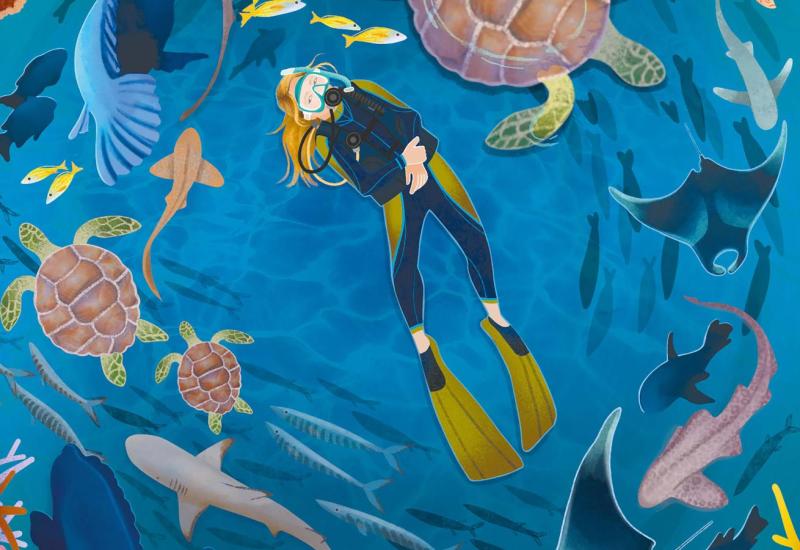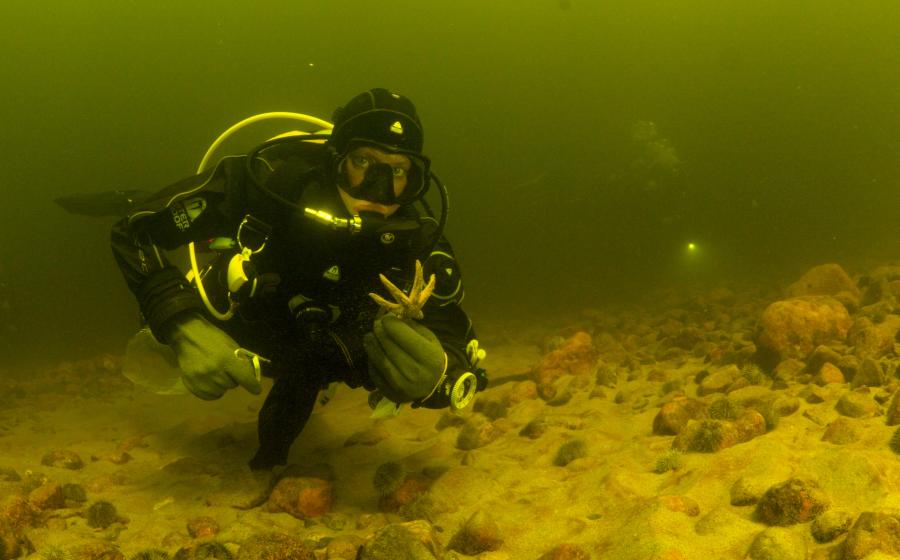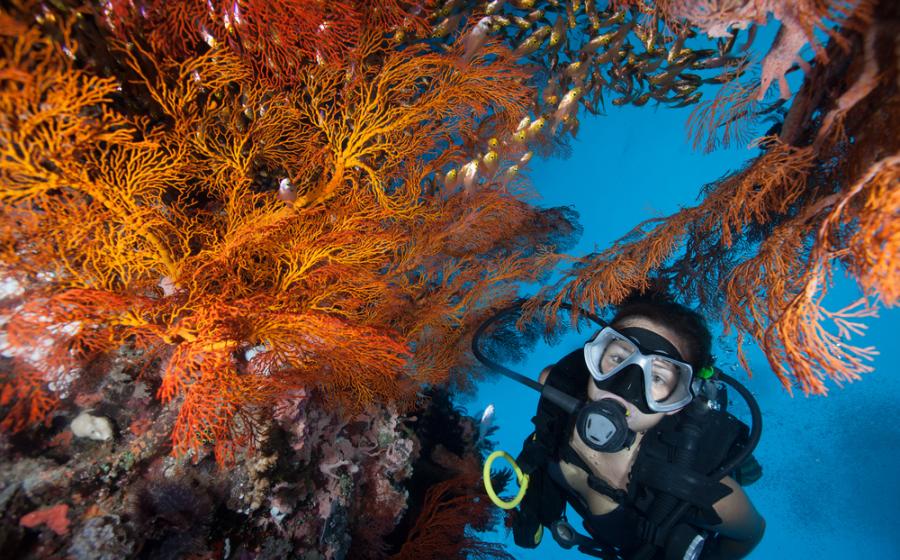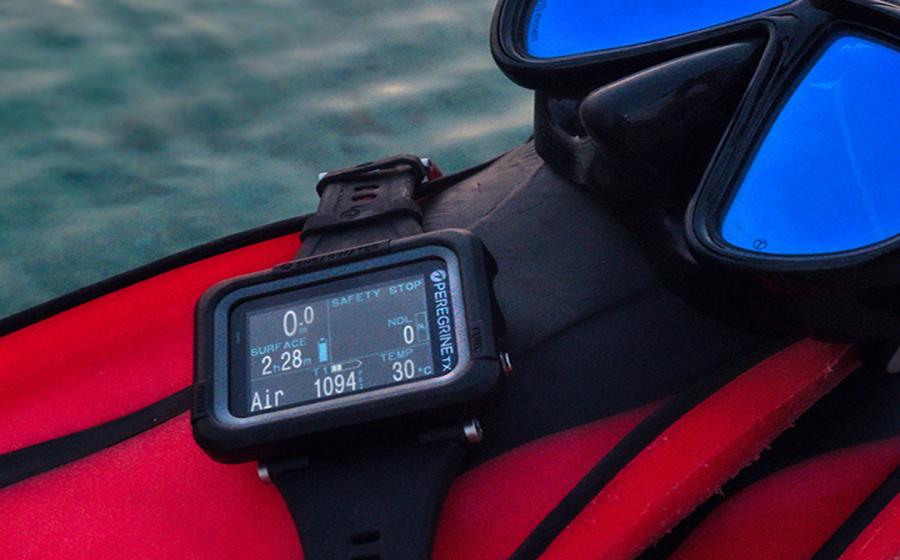Operation No Fear: Diving with and Photographing Oceanic Whitetips
By the time I realize what’s happening, it’s too late.
Tunnel vision is instant: The last thing I remember is the blunt end of an oceanic whitetip shark scratching an itch against my fins — my yellow it-won’t-be-a-problem fins. Normally these fins are so dependable that they don’t warrant a second thought — it was only their bad-as-a-banana color that gave me pause a few days ago when I packed for Cat Island. I knew this Bahamas trip would be different. In places like Nassau and Grand Bahamas, Caribbean reef sharks have become habituated to systematic feedings. The sharks showing up are all regulars, where every handler knows their names — it’s like Cheers, except the cold ones are herring.
In open water, the rules are different. There aren’t any — only procedures based on predictability. Sharks here act more on instinct, less on habit. Pink, baby blue, yellow or other light-colored fins could be interpreted as fish.
Luckily, sharks’ body language is as subtle as a pickup artist. With these predators, a sleek pectoral fin angling downward signals that all bets are off — and the hunt is on. Those same fins slicing horizontally away from the body is good.
This is called polite feeding, and it’s the only behavior Stuart Cove’s allows guests to experience, whether at its Nassau hub or satellite Cat Island operation, run by Beto M. Barbosa and Charlotte Faulkner with boat captain and all-around chill guy Alvin Duncanson.
Earlier that morning, I was the opposite of anxious as White Bungi, the 46-foot-long custom-built Newton, carried us 13 miles offshore of Columbus Point, an idyllic white-sand crescent. It’s a spot favored by big-game fishermen for the same reason we’re here now, engines idling.
At 70 feet, the reef gives way to a 3,000-foot abyss where anything can appear — the closest on-ramp to a superhighway of life.
And it’s officially spring break: For a few magical weeks in April and May, it’s Tunas Gone Wild, a migration of epic proportions. Big-game fishermen score. And the oceanics, practiced hunters that are opportunistic by default, know how to take advantage. It’s little wonder these sharks have made headlines picking off shipwreck victims.
That same energy-saving instinct brings them to Columbus Point. Just as Caribbean reef sharks have learned what it takes to score a handout from a chain-mail-clad feeder, so too oceanics understand what happens when a big haul is on the line, snatching the marlin, sailfish or other prize just before it’s lifted from the salt water.
Anglers in the Billfish Blast tournament held here every May label them as pests. But it’s all that fin flapping and those pulsing hearts that attract the oceanics — and the reason that Stuart Cove’s has started tours here.
Dive teams intentionally replicate the actions of a fishing boat, including gunning the engine into reverse.
“All the cues are there, so the sharks are confused,” Faulkner says. “They’re like, ‘Where the frig is the line?’”
Trickle Down Theory
The process starts with a slick of menhaden oil — a fish-attractant that smells like wax and is as common here as white ice chests. Next comes chum.
Barbosa slides a glove on, and then secures a hunk of mahi against a cutting board while perching off the swim platform. Down comes the hatchet as he flings bloody bites of sushi into the flat sea. Sometimes the sharks appear right away — or, rarely, not at all. It’s the wild, not Disney World. Today it’s only 20 minutes before the first dorsal fin cracks the surface. We climb into our gear, and then plunge in behind Barbosa.
There is a system for the dive: An aluminum cube holds enough enticing scraps to persuade the predators to stick around. Tis is the worm on the hook — the bobber is a standard tagline buoy, which lets surface support know where the divers are at all times because the buoy is tethered to nothing. The whole show travels.
Barbosa keeps a light grip on the line connecting the bait box to the buoy. He stays at the center of the action, and can dole out fish bits if the sharks appear to lose interest — unlikely, given that it’s also raining chum. When Duncanson brings the boat near the group, Faulkner lobs tuna heads and skins into the mix, helping photographers get the open-jaw shots.
For me, the trickle-down of meat is just another obstacle to avoid. I keep it in mind when I first get in the water — when things are still quiet.
Swimming with oceanic whitetips requires mental gymnastics: Just as a juggler stays mindful of every brightly colored ball lobbed aloft, a diver must swivel one’s head about, keeping an eye on the ever-swimming sharks. As a species, they are known for nudging — then attacking — the unsuspecting. But they always knock first.
It’s polite feeding, remember?
In the water, tracking one shark is easy. Then it’s two. Three and four make me thankful for my second cup of coffee. Five and six make me wish I’d thought of a better system of staying aware of their positions. Photographer Elly Wray and I had considered diving with our backs up against one another so we wouldn’t be caught off-guard, bumped from behind. When the dive started, this seemed silly. Now I scan for her. Her hooded head is fixed behind the camera, strobes firing. She’s happy in her element.
That’s one of my first mistakes: I had been watching my buddy, not the sharks, when I first spotted the female whitetip who had me in her scope, pressing steadily forward. With each flick of her tail, my heart beats faster. And yet, this is why I’ve come. The primal rush of a shark approaching, unafraid, is a high that divers rarely encounter on a reef; most sharks keep their distance, darting away when spotted. Photographers call this head-on approach the Mercedes shot. Experience it, and it will be imprinted on your memory.
Right now, as this graceful powerhouse swims closer, it’s like watching target practice. I know it’s just a matter of seconds before it will veer away. Right? And just like that, doubt creeps in, quickly replaced by the sweet smell of panic — at least from the shark’s point of view.
She noses against my fins. I get the bright idea to use that soft plastic to swat her. That plastic is as deterring as a flopping fish, which, incidentally, is exactly what my fins must feel like.
If this were a movie, this is where there would be frames missing.
When I finally snap out of it, I realize I’m gripping Barbosa’s forearm. With his fingers tight against his chest, he makes the smallest OK sign. A question. I nod. With a flat hand, he gestures a reminder to slow my breathing.
Suddenly, the lessons come back. I have been diving with sharks a dozen times. I know the drill. Don’t show fear. Make yourself appear big. Yet I feel so small. The only positive thought flickering through my mind is that as long as I’m clinging to Barbosa, we must look like a giant fish. My other happy thought is that at the rate I am breathing, my tank will soon be low, even though we’re only at a depth of about 15 feet.
Strangely, this starts to relax me. With Barbosa as my personal bouncer, I’m free to admire these pack animals. Their fins are so long that they remind me of outrigger canoes. Oceanics have a cool, faux-aloof confidence — watching them in their natural habitat is a once-in-a-lifetime opportunity, and I suddenly realize how lucky I am. Fifty minutes into the dive, and the sharks still have demonstrated only curiosity, never aggression.
Scanning the group again, this time I see I’m not the only one who made a fashion faux pas. Another member of our group is sporting yellow fins, and he too has the unyielding attention of a shark that demonstrates all manner of pliability as it checks him out. But when the rest of the paparazzi approach this twosome of diver and shark, it’s too much stimuli, and the shark resumes swimming wider circles around us all.
When my air supply is sufficiently low, I signal to Barbosa. Once I’m safely back on the boat, I stop shaking. By the time I down a bottled water, the rest of the gang is aboard — it’s time for the halftime show.
Sharks are like houseguests: Once invited, they get cozy until the cupboards are bare. And right now, we’re packing two Rubbermaid coolers full of fish. The photographers ready their cameras, lowering the domes halfway into the water for over/under shots. The chum-slinging resumes, only this time, the chorus of oohs and ahs is audible.
Memory cards soon fill and residual nitrogen depletes. It’s time for dive two — only now jumping in requires trying not to land on a shark’s backside, their noses nearly pressed against the transom.
Other divers plop in, but I can’t bring myself to giant-stride smack into the middle of circling sharks that have been served only appetizers. While the others take advantage of round two, I join Faulkner on the bow. We’re mere feet from snapping jaws, but from this vantage point, I can re-collect my courage. It’s secondhand experience, but right now, it feels first rate.
Hours later, we make the 40-minute drive east from Hawk’s Nest Marina to Greenwood Beach Resort, a rustic, charming inn favored by Europeans. Dinner is served just after dusk, and I take solace stuffing my face: warm conch fritters, potato soup, lobster dinner and coconut-cream pie. Comfort food. I return to the room, belly bulging, and climb under the cool sheets, nodding off as Wray reviews her images and gives me a pep talk. She admits that she was surprised at how afraid I was, especially given how many years I have been strapping on fins and tanks.
As tiredness sets in and I think about tomorrow, part of me wants nothing more than to walk the white-sand beaches — the ones that Bahamas is famous for — and forget all about sharks.
But it’s not beaches I dream about. When I finally fall asleep, I’m picturing a fearless version of myself — in black fins.
I Am Not Bait
Take two. Morning at Hawk’s Nest Resort and Marina. The Stuart Cove’s crew has already set up our gear. As we embark on the hour-long boat ride, I take advantage of the fact that Andy Brandy Casagrande IV
is on board to shoot video. The GoPro-sponsored daredevil makes a living being fearless around sharks, including swimming outside the cage with great whites. Of course I hit him up for advice on how to be fearless around the sharks. Or for me, perhaps simply less fearful.
He says the biggest thing is to not think or act like bait. The sharks will pick up on that instantly. And with that, I find my mantra: I am not bait.
Faulkner answers another prayer: She hands me a pair of fins. Dark blue ones.
In the water, the first few passes the sharks make are a simple display of power — Lamborghinis doing warm-up laps. I work to make my buoyancy as perfect as possible. I want to avoid needless kicking, so I make like a statue and simply watch.
Sharks are funny. Anyone who has swum with them confidently likens them to dogs. Puppies even. Part of me understands. When interacting with us, they are harmless. They rub against divers to get a reaction.
I think they’re more like cats: curious and seemingly packing an agenda. They’re processing infinite amounts of complex data in any given moment. They scheme.
This occurs to me as I watch them twitch their freckled snouts. The movements are small, almost imperceptible. Te sharks are angling their noses and bodies into different positions, like rotating satellite dishes, to provide better positioning for their jelly-filled, cuplike receptors — the ampullae of Lorenzini. This is how they smell fear.
It’s this moment that I want to hold onto. I’m watching my fear swim around me, and it’s beautiful.
4 tips for shooting oceanic whitetips
1. Stay Shallow Oceanics are most territorial — i.e., more likely to come in close — from zero to 10 feet. This is also the sweet spot for surface reflections, or dappled light on their backs.
2. Don’t Chase Pursuit will only scare the sharks away. The electrical field emitted by your strobes should attract their curiosity.
3. Body language showing too much confidence might prevent a close encounter. Break eye contact from time to time. Letting your guard down (just for show) should bring them in.
4. Strobe Strategy Your camera-to-shark distance can change instantly. Be prepared to reposition and change the output of your strobes from close to camera at low power for a dome-bumping pass to wide set at high power when they’re farther away.
NEED TO KNOW
When to go Oceanic whitetip sharks flock to Cat Island in April and May, coinciding with the tuna migration.
Diving Conditions April and May temps average 75 to 80 degrees F. Visibility extends 70 feet or greater.
Operator Stuart Cove’s Dive Bahamas brings a custom-built, 36-foot Newton to Cat Island, running trips through Hawk’s Nest Resort and Marina.
Price tag From $2,082 per person for 4 nights/3 dive days.
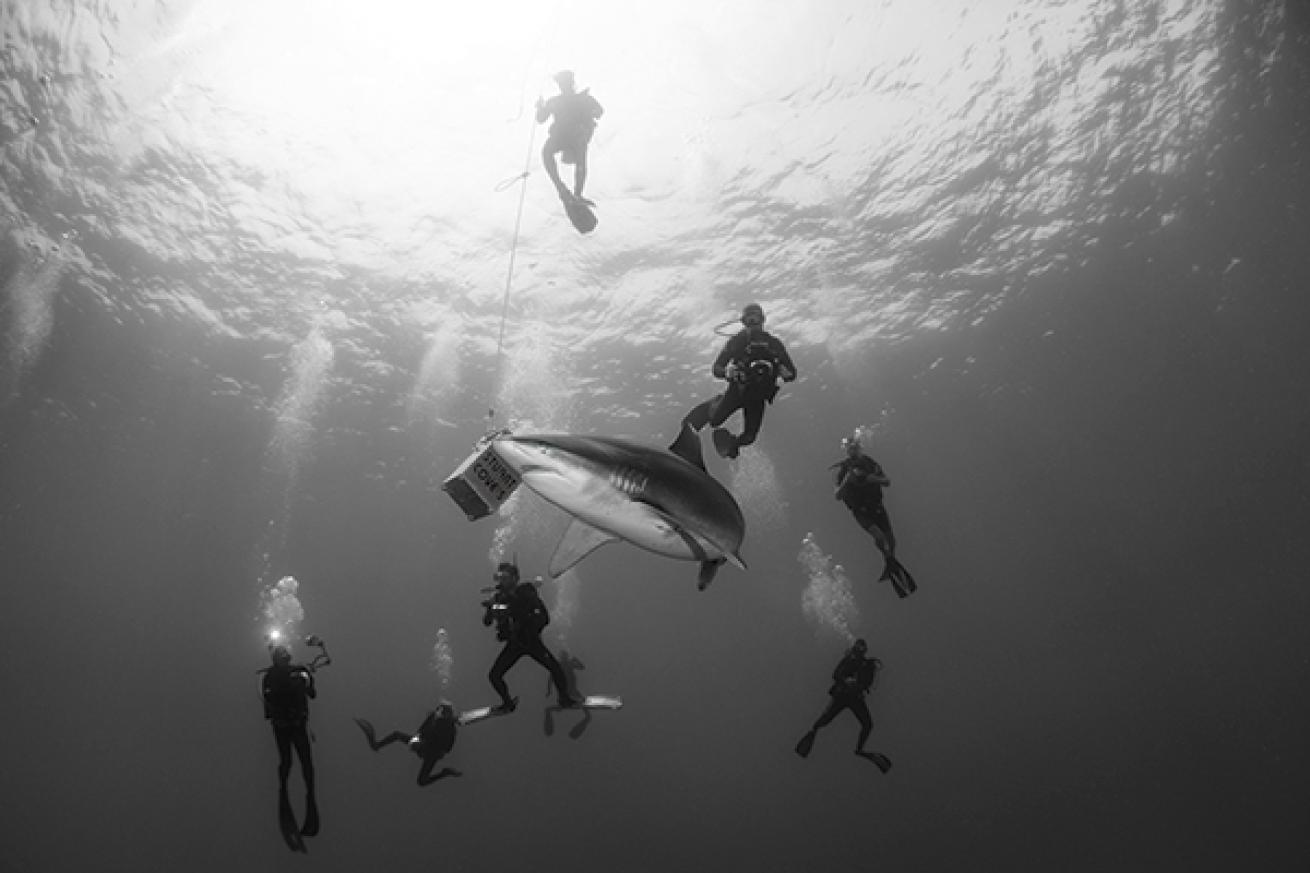
Elly WrayA shark nuzzles the chum bucket in Cat Island.
By the time I realize what’s happening, it’s too late.
Tunnel vision is instant: The last thing I remember is the blunt end of an oceanic whitetip shark scratching an itch against my fins — my yellow it-won’t-be-a-problem fins. Normally these fins are so dependable that they don’t warrant a second thought — it was only their bad-as-a-banana color that gave me pause a few days ago when I packed for Cat Island. I knew this Bahamas trip would be different. In places like Nassau and Grand Bahamas, Caribbean reef sharks have become habituated to systematic feedings. The sharks showing up are all regulars, where every handler knows their names — it’s like Cheers, except the cold ones are herring.
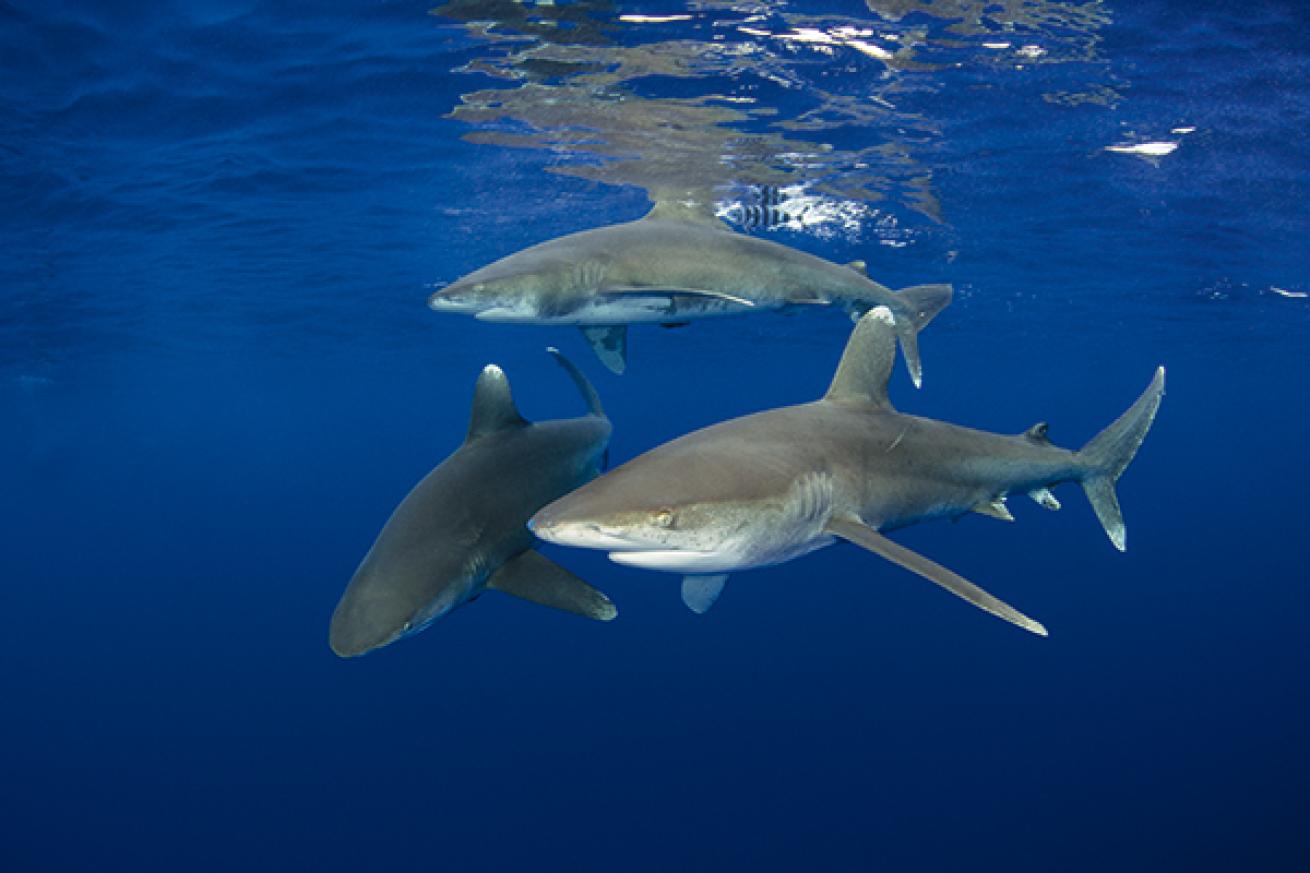
Elly WrayA trio of sharks follows photographer Elly Wray back to the boat during a dive in Cat Island.
In open water, the rules are different. There aren’t any — only procedures based on predictability. Sharks here act more on instinct, less on habit. Pink, baby blue, yellow or other light-colored fins could be interpreted as fish.
Luckily, sharks’ body language is as subtle as a pickup artist. With these predators, a sleek pectoral fin angling downward signals that all bets are off — and the hunt is on. Those same fins slicing horizontally away from the body is good.
This is called polite feeding, and it’s the only behavior Stuart Cove’s allows guests to experience, whether at its Nassau hub or satellite Cat Island operation, run by Beto M. Barbosa and Charlotte Faulkner with boat captain and all-around chill guy Alvin Duncanson.
Earlier that morning, I was the opposite of anxious as White Bungi, the 46-foot-long custom-built Newton, carried us 13 miles offshore of Columbus Point, an idyllic white-sand crescent. It’s a spot favored by big-game fishermen for the same reason we’re here now, engines idling.
At 70 feet, the reef gives way to a 3,000-foot abyss where anything can appear — the closest on-ramp to a superhighway of life.
And it’s officially spring break: For a few magical weeks in April and May, it’s Tunas Gone Wild, a migration of epic proportions. Big-game fishermen score. And the oceanics, practiced hunters that are opportunistic by default, know how to take advantage. It’s little wonder these sharks have made headlines picking off shipwreck victims.
That same energy-saving instinct brings them to Columbus Point. Just as Caribbean reef sharks have learned what it takes to score a handout from a chain-mail-clad feeder, so too oceanics understand what happens when a big haul is on the line, snatching the marlin, sailfish or other prize just before it’s lifted from the salt water.
Anglers in the Billfish Blast tournament held here every May label them as pests. But it’s all that fin flapping and those pulsing hearts that attract the oceanics — and the reason that Stuart Cove’s has started tours here.
Dive teams intentionally replicate the actions of a fishing boat, including gunning the engine into reverse.
“All the cues are there, so the sharks are confused,” Faulkner says. “They’re like, ‘Where the frig is the line?’”
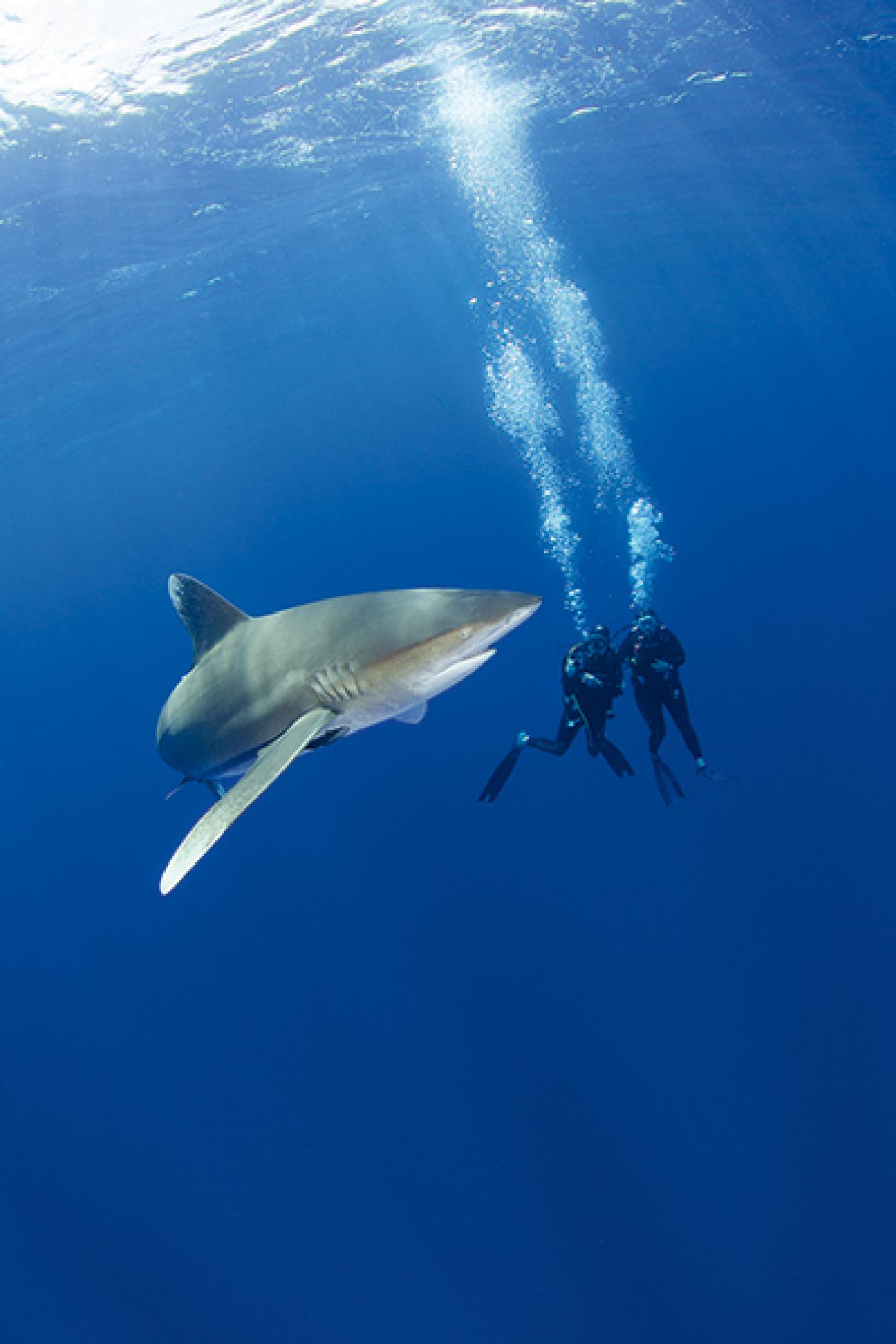
Elly WrayBrooke Morton with "bodyguard."
Trickle Down Theory
The process starts with a slick of menhaden oil — a fish-attractant that smells like wax and is as common here as white ice chests. Next comes chum.
Barbosa slides a glove on, and then secures a hunk of mahi against a cutting board while perching off the swim platform. Down comes the hatchet as he flings bloody bites of sushi into the flat sea. Sometimes the sharks appear right away — or, rarely, not at all. It’s the wild, not Disney World. Today it’s only 20 minutes before the first dorsal fin cracks the surface. We climb into our gear, and then plunge in behind Barbosa.
There is a system for the dive: An aluminum cube holds enough enticing scraps to persuade the predators to stick around. Tis is the worm on the hook — the bobber is a standard tagline buoy, which lets surface support know where the divers are at all times because the buoy is tethered to nothing. The whole show travels.
Barbosa keeps a light grip on the line connecting the bait box to the buoy. He stays at the center of the action, and can dole out fish bits if the sharks appear to lose interest — unlikely, given that it’s also raining chum. When Duncanson brings the boat near the group, Faulkner lobs tuna heads and skins into the mix, helping photographers get the open-jaw shots.
For me, the trickle-down of meat is just another obstacle to avoid. I keep it in mind when I first get in the water — when things are still quiet.
Swimming with oceanic whitetips requires mental gymnastics: Just as a juggler stays mindful of every brightly colored ball lobbed aloft, a diver must swivel one’s head about, keeping an eye on the ever-swimming sharks. As a species, they are known for nudging — then attacking — the unsuspecting. But they always knock first.
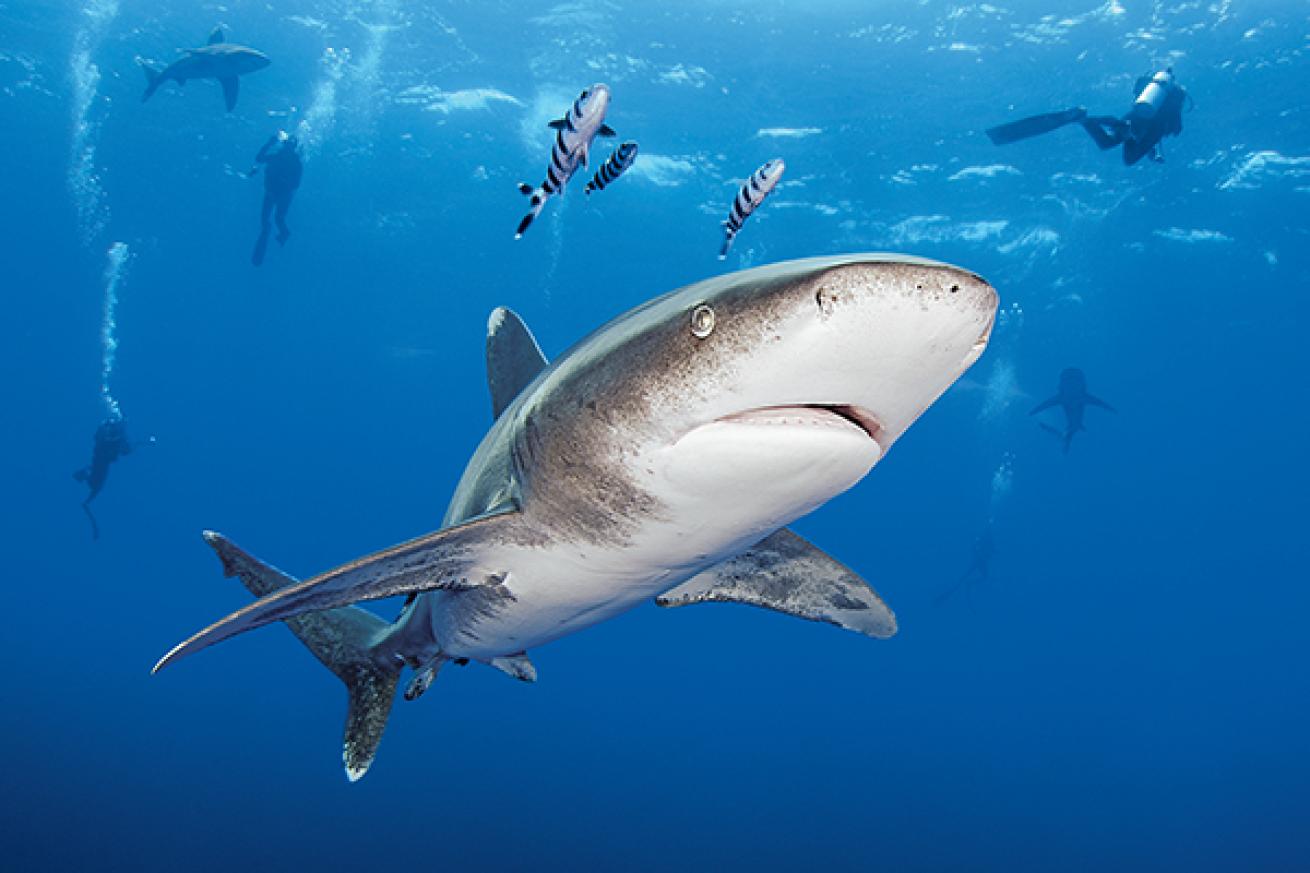
Elly WrayIt took 20 minutes before dorsal fins broke the surface during this Cat Island dive. Within minutes afterward, there were at least six sharks swimming about.
It’s polite feeding, remember?
In the water, tracking one shark is easy. Then it’s two. Three and four make me thankful for my second cup of coffee. Five and six make me wish I’d thought of a better system of staying aware of their positions. Photographer Elly Wray and I had considered diving with our backs up against one another so we wouldn’t be caught off-guard, bumped from behind. When the dive started, this seemed silly. Now I scan for her. Her hooded head is fixed behind the camera, strobes firing. She’s happy in her element.
That’s one of my first mistakes: I had been watching my buddy, not the sharks, when I first spotted the female whitetip who had me in her scope, pressing steadily forward. With each flick of her tail, my heart beats faster. And yet, this is why I’ve come. The primal rush of a shark approaching, unafraid, is a high that divers rarely encounter on a reef; most sharks keep their distance, darting away when spotted. Photographers call this head-on approach the Mercedes shot. Experience it, and it will be imprinted on your memory.
Right now, as this graceful powerhouse swims closer, it’s like watching target practice. I know it’s just a matter of seconds before it will veer away. Right? And just like that, doubt creeps in, quickly replaced by the sweet smell of panic — at least from the shark’s point of view.
She noses against my fins. I get the bright idea to use that soft plastic to swat her. That plastic is as deterring as a flopping fish, which, incidentally, is exactly what my fins must feel like.
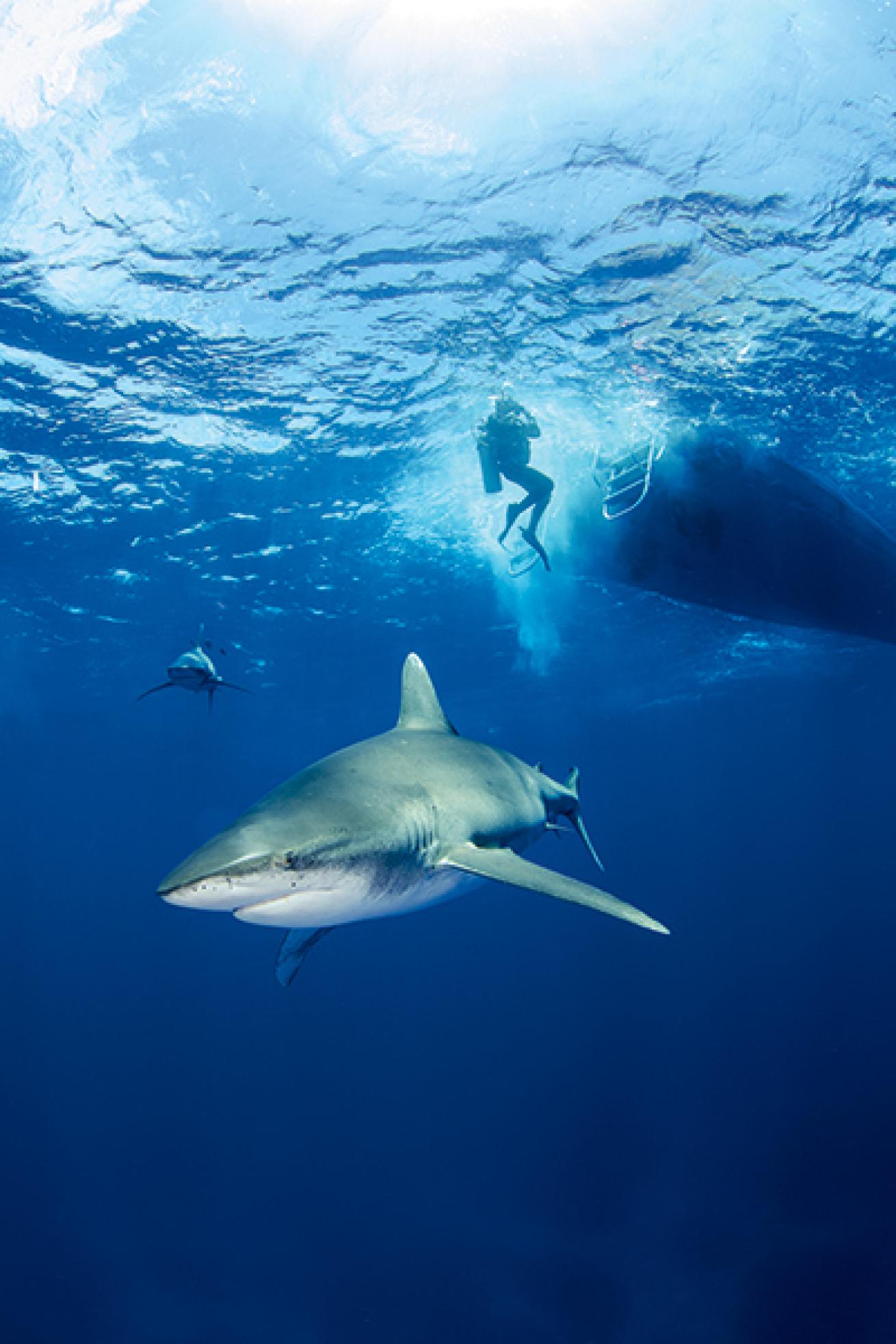
..
If this were a movie, this is where there would be frames missing.
When I finally snap out of it, I realize I’m gripping Barbosa’s forearm. With his fingers tight against his chest, he makes the smallest OK sign. A question. I nod. With a flat hand, he gestures a reminder to slow my breathing.
Suddenly, the lessons come back. I have been diving with sharks a dozen times. I know the drill. Don’t show fear. Make yourself appear big. Yet I feel so small. The only positive thought flickering through my mind is that as long as I’m clinging to Barbosa, we must look like a giant fish. My other happy thought is that at the rate I am breathing, my tank will soon be low, even though we’re only at a depth of about 15 feet.
Strangely, this starts to relax me. With Barbosa as my personal bouncer, I’m free to admire these pack animals. Their fins are so long that they remind me of outrigger canoes. Oceanics have a cool, faux-aloof confidence — watching them in their natural habitat is a once-in-a-lifetime opportunity, and I suddenly realize how lucky I am. Fifty minutes into the dive, and the sharks still have demonstrated only curiosity, never aggression.
Scanning the group again, this time I see I’m not the only one who made a fashion faux pas. Another member of our group is sporting yellow fins, and he too has the unyielding attention of a shark that demonstrates all manner of pliability as it checks him out. But when the rest of the paparazzi approach this twosome of diver and shark, it’s too much stimuli, and the shark resumes swimming wider circles around us all.
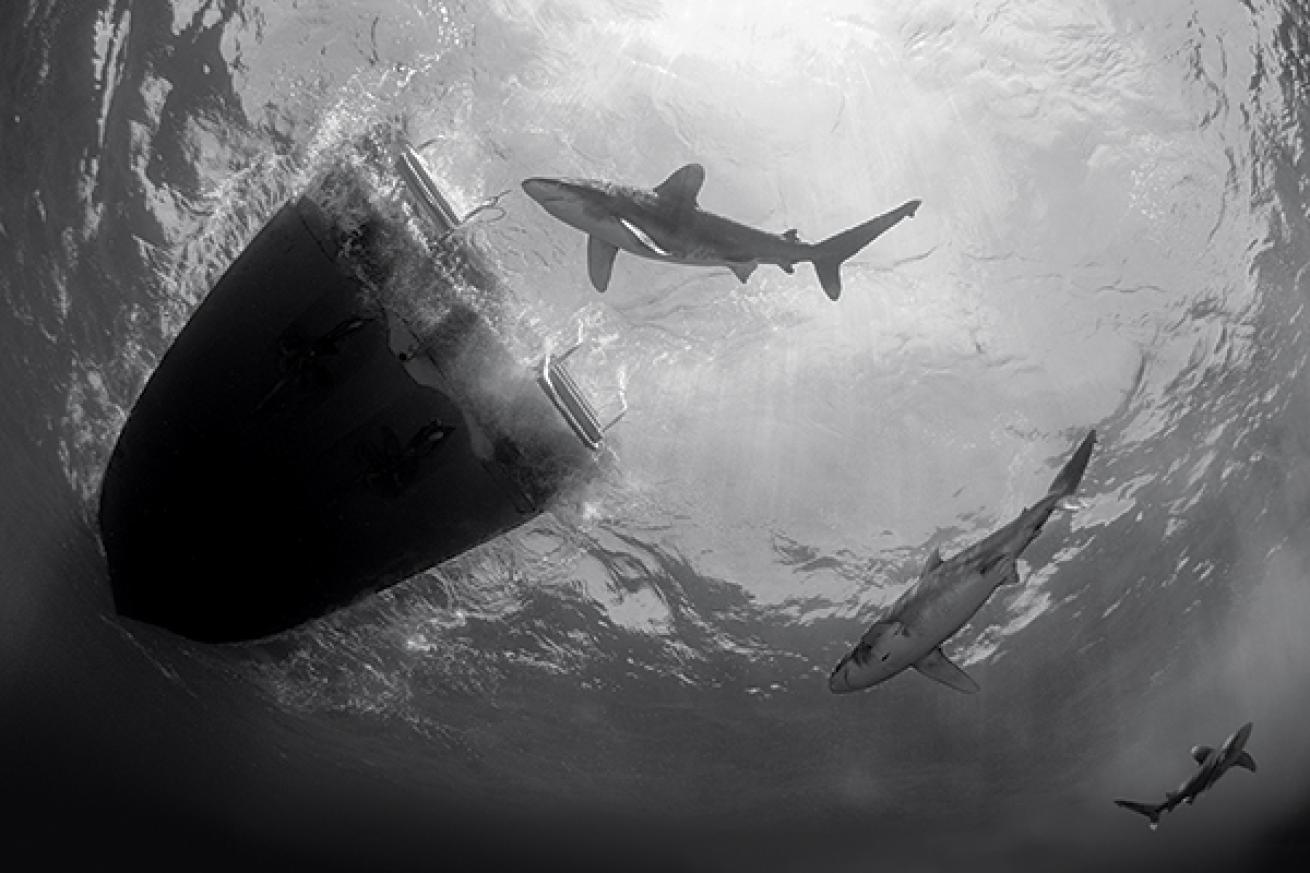
Elly WrayChumming and emulating a fishing boat help to attract oceanic whitetip sharks in Cat Island, Bahamas.
When my air supply is sufficiently low, I signal to Barbosa. Once I’m safely back on the boat, I stop shaking. By the time I down a bottled water, the rest of the gang is aboard — it’s time for the halftime show.
Sharks are like houseguests: Once invited, they get cozy until the cupboards are bare. And right now, we’re packing two Rubbermaid coolers full of fish. The photographers ready their cameras, lowering the domes halfway into the water for over/under shots. The chum-slinging resumes, only this time, the chorus of oohs and ahs is audible.
Memory cards soon fill and residual nitrogen depletes. It’s time for dive two — only now jumping in requires trying not to land on a shark’s backside, their noses nearly pressed against the transom.
Other divers plop in, but I can’t bring myself to giant-stride smack into the middle of circling sharks that have been served only appetizers. While the others take advantage of round two, I join Faulkner on the bow. We’re mere feet from snapping jaws, but from this vantage point, I can re-collect my courage. It’s secondhand experience, but right now, it feels first rate.
Hours later, we make the 40-minute drive east from Hawk’s Nest Marina to Greenwood Beach Resort, a rustic, charming inn favored by Europeans. Dinner is served just after dusk, and I take solace stuffing my face: warm conch fritters, potato soup, lobster dinner and coconut-cream pie. Comfort food. I return to the room, belly bulging, and climb under the cool sheets, nodding off as Wray reviews her images and gives me a pep talk. She admits that she was surprised at how afraid I was, especially given how many years I have been strapping on fins and tanks.
As tiredness sets in and I think about tomorrow, part of me wants nothing more than to walk the white-sand beaches — the ones that Bahamas is famous for — and forget all about sharks.
But it’s not beaches I dream about. When I finally fall asleep, I’m picturing a fearless version of myself — in black fins.
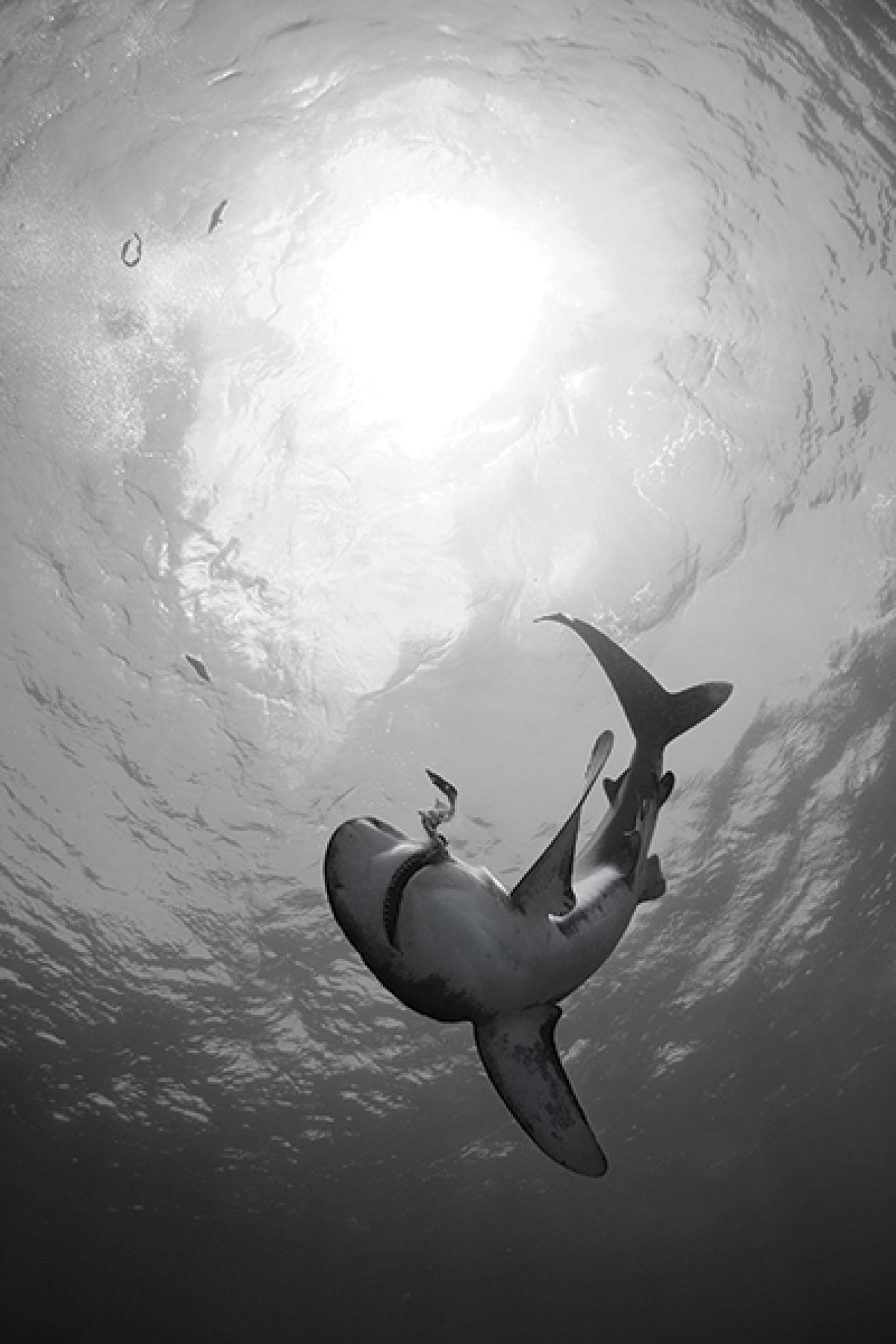
Elly WrayA single oceanic whitetip shark grabs a mahi skin midwater.
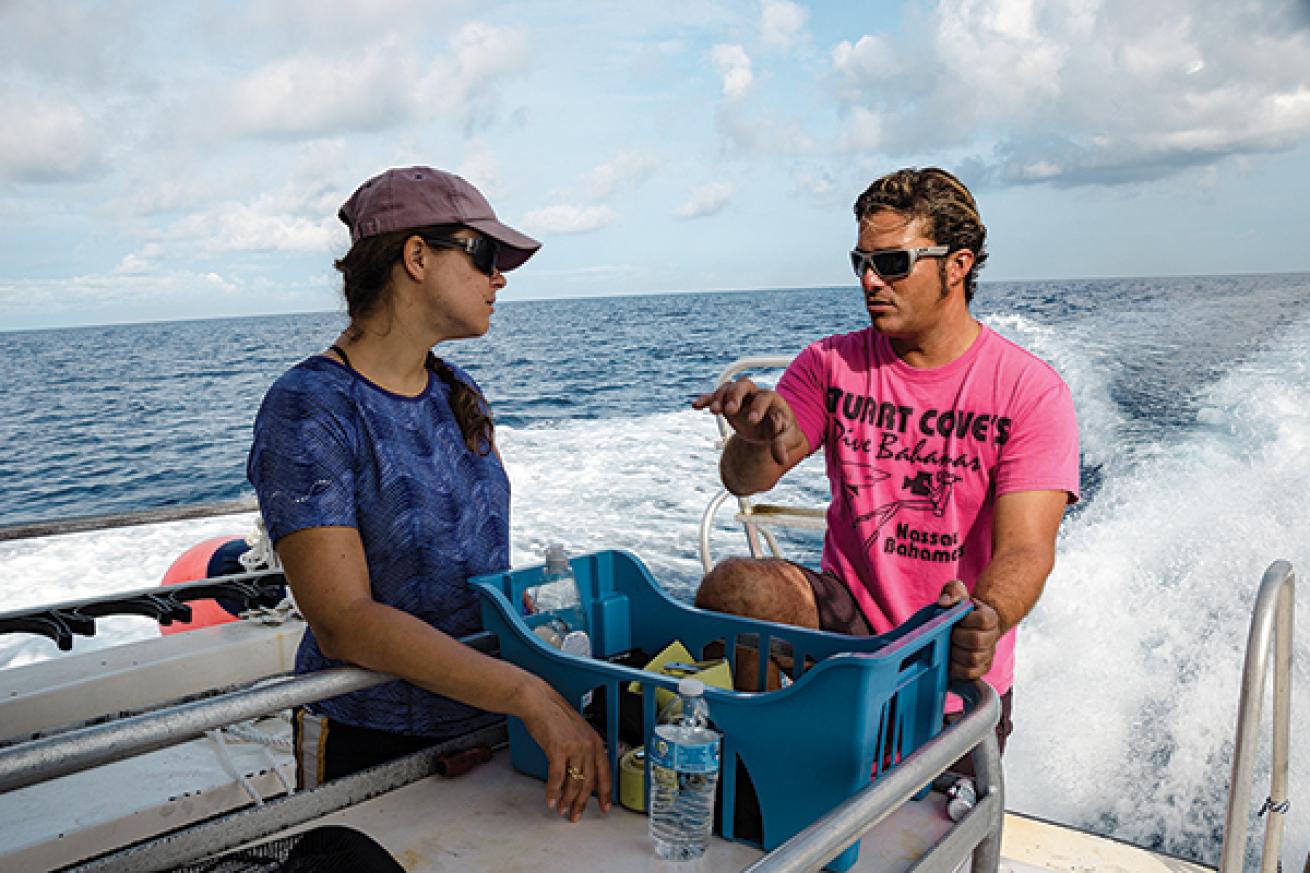
Elly WrayThe author with "bodyguard" Beto M. Barbosa aboard the White Bungi in Cat Island.
I Am Not Bait
Take two. Morning at Hawk’s Nest Resort and Marina. The Stuart Cove’s crew has already set up our gear. As we embark on the hour-long boat ride, I take advantage of the fact that Andy Brandy Casagrande IV
is on board to shoot video. The GoPro-sponsored daredevil makes a living being fearless around sharks, including swimming outside the cage with great whites. Of course I hit him up for advice on how to be fearless around the sharks. Or for me, perhaps simply less fearful.
He says the biggest thing is to not think or act like bait. The sharks will pick up on that instantly. And with that, I find my mantra: I am not bait.
Faulkner answers another prayer: She hands me a pair of fins. Dark blue ones.
In the water, the first few passes the sharks make are a simple display of power — Lamborghinis doing warm-up laps. I work to make my buoyancy as perfect as possible. I want to avoid needless kicking, so I make like a statue and simply watch.
Sharks are funny. Anyone who has swum with them confidently likens them to dogs. Puppies even. Part of me understands. When interacting with us, they are harmless. They rub against divers to get a reaction.
I think they’re more like cats: curious and seemingly packing an agenda. They’re processing infinite amounts of complex data in any given moment. They scheme.
This occurs to me as I watch them twitch their freckled snouts. The movements are small, almost imperceptible. Te sharks are angling their noses and bodies into different positions, like rotating satellite dishes, to provide better positioning for their jelly-filled, cuplike receptors — the ampullae of Lorenzini. This is how they smell fear.
It’s this moment that I want to hold onto. I’m watching my fear swim around me, and it’s beautiful.
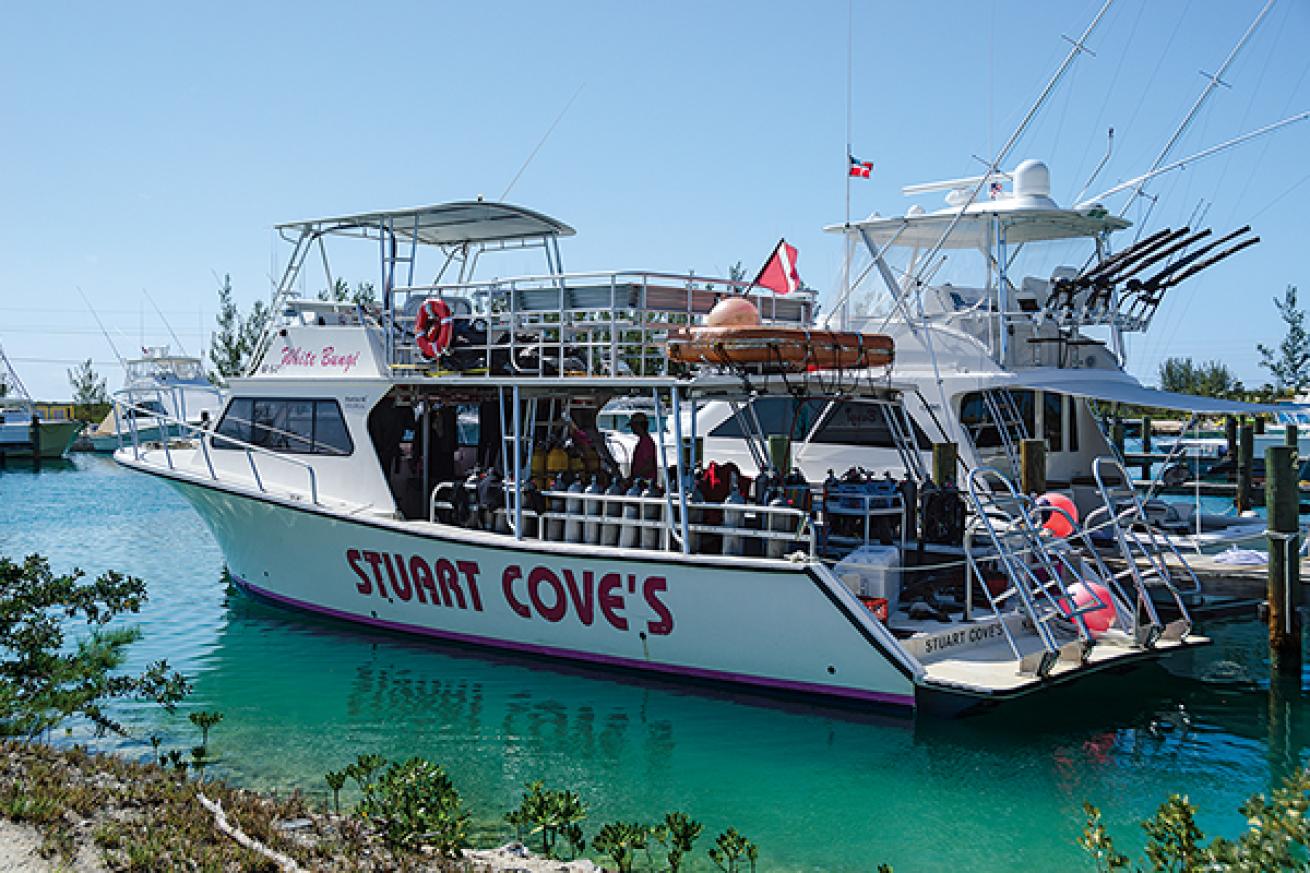
Elly WrayStuart Cove's White Bungi; its crew spend the month of May on Cat Island.
4 tips for shooting oceanic whitetips
1. Stay Shallow Oceanics are most territorial — i.e., more likely to come in close — from zero to 10 feet. This is also the sweet spot for surface reflections, or dappled light on their backs.
2. Don’t Chase Pursuit will only scare the sharks away. The electrical field emitted by your strobes should attract their curiosity.
3. Body language showing too much confidence might prevent a close encounter. Break eye contact from time to time. Letting your guard down (just for show) should bring them in.
4. Strobe Strategy Your camera-to-shark distance can change instantly. Be prepared to reposition and change the output of your strobes from close to camera at low power for a dome-bumping pass to wide set at high power when they’re farther away.
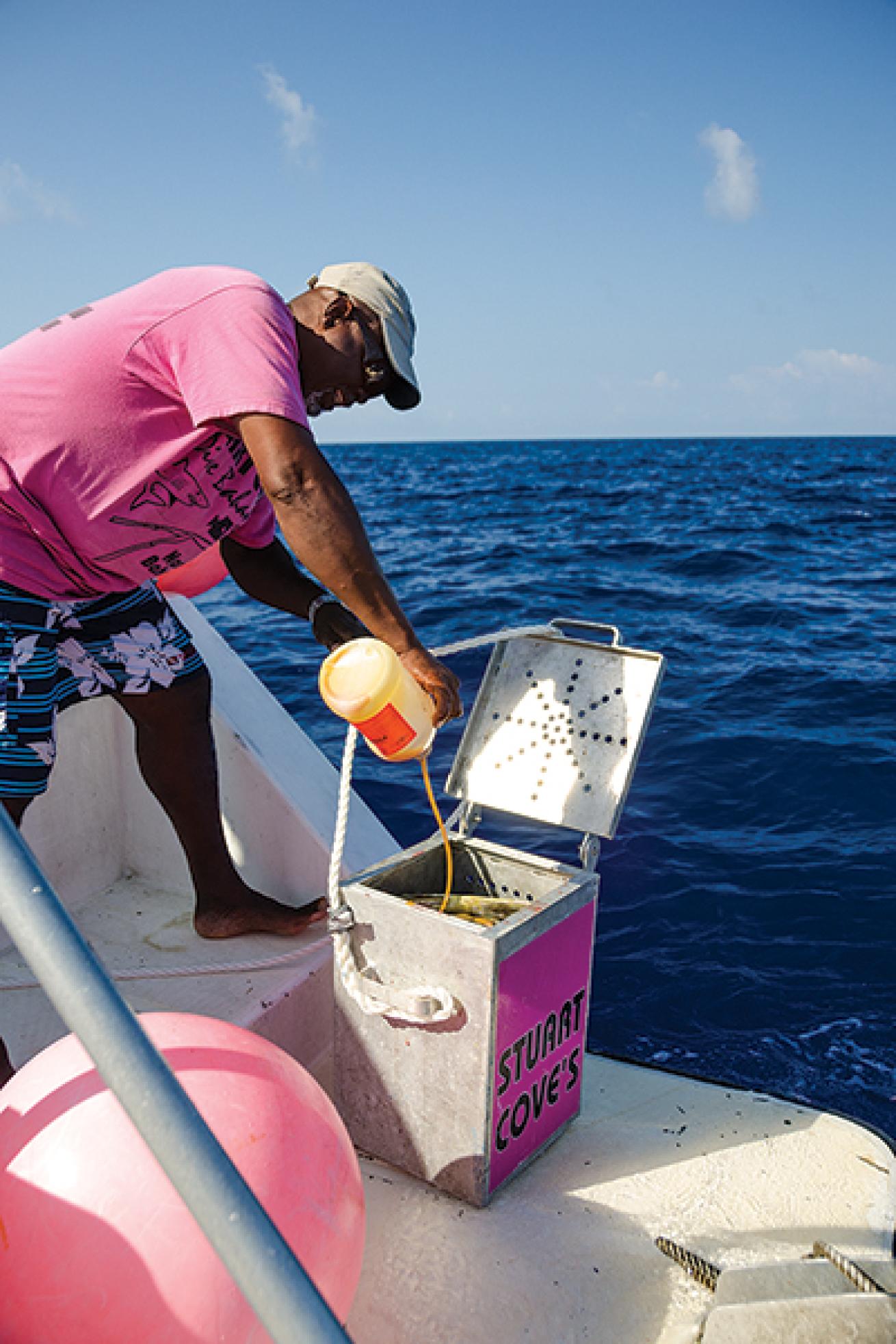
Elly WrayA chum box is filled by one of the members of Stuart Cove's dive crew.
NEED TO KNOW
When to go Oceanic whitetip sharks flock to Cat Island in April and May, coinciding with the tuna migration.
Diving Conditions April and May temps average 75 to 80 degrees F. Visibility extends 70 feet or greater.
Operator Stuart Cove’s Dive Bahamas brings a custom-built, 36-foot Newton to Cat Island, running trips through Hawk’s Nest Resort and Marina.
Price tag From $2,082 per person for 4 nights/3 dive days.



